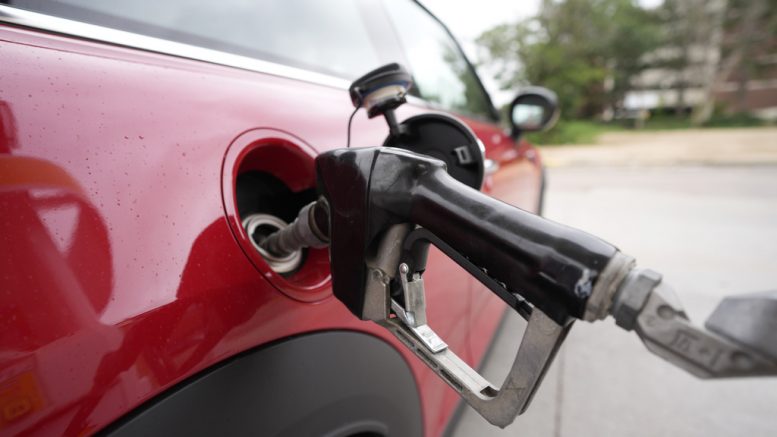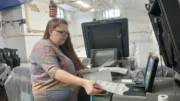WASHINGTON (AP) — Inflation jumped last month largely because of a spike in gas prices but other costs rose more slowly, suggesting price pressures are easing at a gradual pace.
In a set of conflicting data released Wednesday, the Labor Department said the consumer price index rose 3.7% in August from a year ago, up from a 3.2% annual pace in July. Yet excluding the volatile food and energy categories, so-called core prices rose 4.3%, a step back from 4.7% in July and the smallest increase in nearly two years. That is still far from the Federal Reserve’s 2% target.
The big rise in gas prices accounted for more than half of the monthly inflation increase, the government said.
Despite the seemingly divergent figures, the decline in the core measure points to inflation coming under control, but at a much more gradual pace than earlier this year. The Federal Reserve closely tracks core prices because they are seen as a better indicator of future inflation trends.
The Fed is widely expected to skip an interest rate hike at its meeting next week. Wednesday’s figures keep the prospect of another rate increase later this year on the table, however, perhaps at its November or December meetings, economists said, because core prices ticked up a bit faster in August than in July.
Wednesday’s report suggested that after inflation faded quickly over the spring and the summer, future declines will be much more gradual. Inflation dropped to 3% in June, down from a 9.1% peak in June 2022. Some of the forces that pulled down prices earlier this year — such as lower gas prices and improving supply chains, which reduced the cost of goods like furniture — have largely played out, economists say.
“We’re getting to the stage where we’ve basically had all the low hanging fruit in terms of disinflation,” said Blerina Uruci, an economist at T. Rowe Price. “The progress on core inflation over the coming months is going to be slow and it’s going to be uneven.”
On a monthly basis, consumer prices jumped 0.6% in August, the biggest increase in more than a year. Gas prices spiked nearly 11%, though they have since leveled off: According to AAA, the average nationwide price at the pump was $3.85 on Wednesday, unchanged from a month ago.
Excluding food and energy, core prices increased just 0.3% in August from July, though that is up from 0.2% in the two previous months.
Energy costs rose 5.6% just in August, the biggest monthly increase since June 2022. Auto insurance prices also soared, rising 2.4% last month and 19.1% compared with a year ago. The sharp increase in new car prices in the past two years has also made them more expensive to insure and repair.
Airfares soared 4.9% in August from July, though after two months of sharp declines. At the same time, used car costs dropped 1.2%, the third straight decrease, while hotel prices fell 3%, also the third consecutive fall.
Grocery prices moved up 0.2%, a trend that has strained many household’s finances. But food cost increases are cooling: They rose 3% compared with a year ago, down from double-digit increases last year.
Prices increase are slowing yet, as any American can attest, food, rent, automobiles, appliances, all cost considerably more than they did two years ago.
While filling up her car with gas Tuesday night in Falls Church, Virginia, Francesca, who declined to give her last name, said she still notices how much higher her grocery bill has gotten.
“We’re not buying crazy things, like caviar, just the basics,” she said, referring to her weekly food shopping. “And it’s like $150,” compared to a tab of closer to $100 before the pandemic.
Still, Federal Reserve officials are becoming more open to the idea that inflation is coming under control, though chair Jerome Powell warned last month it was still “too high.”
In his high-profile speech at Jackson Hole, Wyoming, Powell said the Fed would proceed “carefully” with any further rate hikes, which many economists saw as an opening for the Fed to skip a rate increase at its September 19-20 meeting. When the Fed increases its key rate, it typically raises the cost of mortgages, auto loans, and business borrowing.
The Fed has lifted its benchmark interest rate 11 times in the past 12 meetings to about 5.4%, the highest level in 22 years. It increased the rate a quarter-point in July after leaving it unchanged in June.
Lorie Logan, president of the Federal Reserve’s Dallas branch, said last week that “another skip could be appropriate” at its next meeting September 19-20, “but skipping does not imply stopping.”
Wall Street traders see only a 3% chance of a rate hike next week, according to CME’s FedWatch. But they have priced in a 40% chance for an increase at the Fed’s subsequent meeting in November.
Wednesday’s report shows prices are sticky enough “to have another rate hike this year,” said Tim Duy, chief U.S. economist at SGH Macro.
Duy said that the economy is expanding at a healthy pace, confounding long-standing fears that a recession is imminent. Americans boosted their spending at restaurants and retailers in July, and hiring has remained solid. Yet Duy added that one risk posed by the steady growth is that it could keep inflation pressures high. Companies are boosting pay to find and keep employees, which is great for workers, but can lead businesses to raise prices to offset the higher labor costs.
Strikes and labor disputes this year could lead to more healthy pay gains. The Teamsters won robust wage increases in recent negotiations with UPS, while American Airline pilots also secured higher pay in a new contract. The United Auto Workers is also seeking higher pay from the three major U.S. automakers.
The push for higher pay, however, comes after incomes for most Americans trailed inflation for much of the past two years. A report from the Census Bureau Tuesday showed that the inflation-adjusted income for a typical household dropped 2.3% last year. Economists expect workers to keep pushing to make up for lost ground.
The European Central Bank is also contemplating lifting its key interest rate at its next meeting Thursday, though officials could choose to also skip an increase. The European economy is nearing recession as it struggles with high inflation and rising borrowing costs.
The 20 countries that use the euro currency are expected to grow just 0.8% this year, according to a gloomy forecast issued Monday by the European Commission, the European Union’s executive arm. Germany’s economy, the EU’s largest, is projected to shrink 0.4%. Inflation in the EU is higher than in the U.S. — it was 5.3% in July — though that is half of the 10.6% peak reached in October.










































